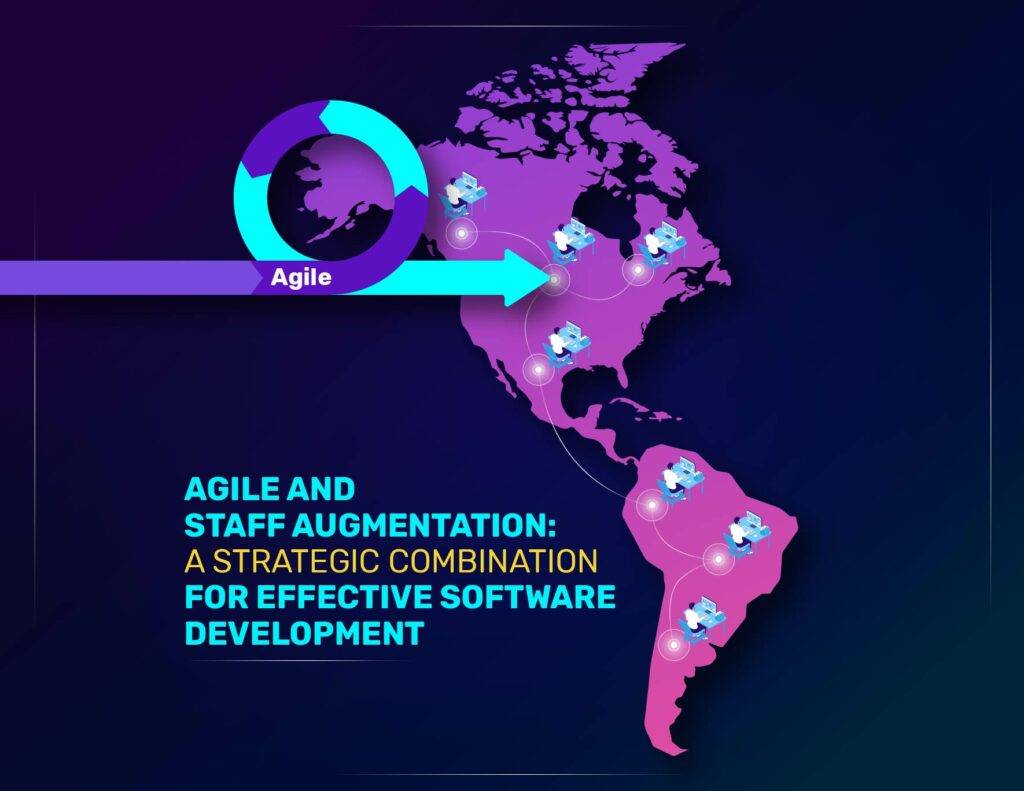In today’s rapidly evolving business landscape, companies need to navigate and adapt to change swiftly. Agile and staff augmentation are two concepts that have proven instrumental in helping businesses remain resilient in such dynamism. Agile, a robust framework for managing and adapting to change, has long been leveraged by software development teams for its focus on iterative progress, flexibility, and collaborative problem-solving. On the other hand, staff augmentation—a strategy for adding skilled personnel to your team based on the current project needs—provides a practical solution to the fluctuating talent demands in a project lifecycle.
Individually, both Agile and staff augmentation offers substantial advantages. But, when combined, they can supercharge a team’s capability to deliver high-quality results consistently while accommodating change effectively.
Understanding Agile and Staff Augmentation
Before we dive into the interplay between Agile and Staff Augmentation, we must grasp the fundamental concepts behind these two approaches.
Agile Methodology:
Originating from the world of software development, Agile methodology has emerged as a highly effective approach to project management. It is defined by iterative development cycles, known as “sprints,” which allow for frequent reassessment and adaptation of plans. This promotes flexibility and responsiveness to change, which are crucial in today’s fast-paced business environment.
At its core, Agile emphasizes collaboration, customer satisfaction, and continuous improvement. The methodology is guided by principles in the Agile Manifesto, such as valuing individuals and interactions over processes and tools and responding to change over following a rigid plan.
Staff Augmentation:
Staff augmentation is a strategic approach to talent acquisition and management. It enables businesses to temporarily hire skilled professionals on a contract basis to supplement their in-house teams during peak workloads, special projects, or when specific expertise is needed. Staff augmentation allows businesses to scale their resources up or down based on project requirements, promoting efficiency and cost-effectiveness.
By leveraging staff augmentation, businesses can access a large talent pool with diverse skills without the long-term financial commitment associated with full-time hires. Moreover, it allows them to swiftly adjust their team composition in response to project changes, ensuring they always have the right people for the job.
Synergizing Agile with Staff Augmentation
When examining the principles underpinning Agile and staff augmentation, it becomes clear why they form such a successful partnership. Both prioritize flexibility, adaptability, and a commitment to delivering value rapidly and continuously.
In Agile methodologies, teams embrace change, value individuals and interactions, focus on working software, and favor customer collaboration. Similarly, staff augmentation offers the flexibility to adapt to changes rapidly – scaling teams up or down as per project requirements, fostering interactions between in-house and augmented staff, and enabling the creation of working software by providing specific skill sets when needed.
Several organizations have leveraged this synergy to their advantage. For instance, a fintech company facing a surge in demand for their services due to a sudden market shift decided to augment their in-house Agile team with additional developers skilled in the latest technologies. Through regular sprint meetings, pair programming, and constant communication, the augmented team members could integrate quickly, sharing their knowledge, bringing in fresh perspectives, and ultimately helping the company meet its increased demand efficiently.
A software company wanted to expand its product portfolio. They opted for staff augmentation, bringing specialists for the new projects. Despite being geographically dispersed, the team followed Agile principles, regularly communicating and collaborating. This led to the successful launch of new products.
These examples illustrate that, with proper planning and execution, Agile teams can successfully integrate augmented staff, leveraging the shared principles of Agile and staff augmentation. The resultant synergy not only aids in fulfilling immediate project requirements but can also foster innovation and continuous improvement – core tenets of the Agile mindset.
Overcoming Potential Challenges
While the benefits of integrating staff augmentation into an Agile environment are significant, it has its potential challenges. Typical concerns may include the following:
Communication: Agile thrives on open and constant communication. When you bring in external partners, there could be concerns about maintaining effective communication, especially in a remote setup.
Cultural Fit: Every organization has a unique culture, and Agile teams often have specific working methods. Concerns about how an external partner will fit into the existing culture and practices might exist.
Onboarding and Training: The need for effective and efficient onboarding of augmented staff to ensure they understand the Agile processes and tools can be daunting.
Quality Control: With new members joining the team, maintaining the quality of work may be a concern.
However, these challenges can be effectively managed, and lessons from successful integrations of staff augmentation into Agile environments can guide the way:
Invest in Communication Tools and Practices: Case studies have shown that investing in robust communication tools and setting clear communication protocols can ensure seamless integration of augmented staff. Regular meetings, instant messaging platforms, video conferencing, and shared digital workspaces can all facilitate effective communication.
Cultural Onboarding: Include cultural fit when selecting an augmentation partner. Successful organizations have also set up cultural onboarding programs to help the augmented staff understand and adapt to the company’s culture and Agile practices.
Effective Training: Investing time and resources in thorough onboarding and training the augmented staff in Agile methodologies, tools, and practices used in the team can ensure they hit the ground running.
Quality Assurance Practices: Implementing strong quality assurance practices, including code reviews, pair programming, and automated testing, can ensure the quality of work remains high even with integrating new team members.
Unique Benefits of Staff Augmentation for Agile Teams
Staff augmentation serves as a solution to staffing needs and brings unique advantages that can enhance Agile practices.
Scalability and Flexibility: Agile thrives on flexibility and quick response to change. Staff augmentation allows for the rapid scaling of teams in response to project requirements, which aligns well with Agile’s principles of adaptability. It helps ensure that resources can be added or removed based on the backlog and project needs, supporting Agile development’s iterative and incremental nature.
Access to Specialized Skills: Sometimes, an Agile project may need specific skills unavailable in-house. Staff augmentation provides access to a broad range of specialists who can be brought in when their expertise is required, thereby enhancing the capability of the Agile team.
Continuous Delivery: The ability to quickly scale teams helps maintain the pace of development and supports the Agile principle of continuous delivery.
Cost-Effectiveness: By bringing in skilled professionals only when needed, organizations can make significant cost savings, making the most of their budget in an Agile, iterative manner.
Rapid Testing of New Ideas: Staff augmentation enables teams to quickly test new ideas by bringing in additional personnel to develop and implement prototypes or minimum viable products (MVPs). This allows the core team to focus on their primary tasks while testing new concepts without diverting essential resources.
Case Examples:
A technology company that needs to quickly scale its development team for a critical project used staff augmentation to bring in skilled developers. This enabled the team to maintain the pace of development, adhere to Agile sprints, and meet project deadlines without overworking the in-house team.
A startup working on an innovative solution used staff augmentation to bring in specialists for specific Agile development cycle stages. This improved the quality of the product and allowed the company to manage costs effectively.
A high-tech company wanted to test the waters with a new feature on its product. It used staff augmentation to build a small team that created an MVP to test the market while the internal team remained focused on its priorities. The augmented staff developed the MVP and leveraged their expertise to promote the new feature on social media and measure sentiment. This real-time feedback helped the company make quick iterations based on user responses without distracting its internal resources.
Tips to Successfully Implement Agile with Nearshoring Staff Augmentation
While Agile and staff augmentation can complement each other well, achieving this synergy requires careful planning and execution. Here are some practical tips for companies looking to integrate Agile methodologies with nearshoring staff augmentation effectively:
Choose a Nearshoring Partner that Understands Agile: It’s vital to ensure your nearshoring partner is well-versed in Agile methodologies and has proven experience implementing them in their work. They should be familiar with Agile principles, ceremonies, and tools. This understanding will allow them to fit seamlessly into your Agile practices and contribute effectively from the outset.
Adopt Strong Leadership Roles: Integrating a nearshoring partner into your Agile team will require clear leadership. This involves defining roles and responsibilities for the augmented team members, providing direction, and facilitating open and regular communication. It’s essential to instill Agile values in the team and ensure everyone, including the nearshoring team, is aligned with the project goals.
Establish Clear Communication Channels: Effective communication is a crucial principle of Agile. Establishing clear communication channels is vital, ensuring everyone, including the nearshoring team, is kept in the loop about project developments, changes, and expectations. Regular check-ins, meetings, and open discussions should be encouraged.
Leverage Technology for Collaboration: There are numerous collaboration and project management tools in Agile teams. Tools for video conferencing, real-time document editing, project tracking, and communication can help bridge the geographical gap and make collaboration seamless.
Foster Remote Collaboration and Personal Connection: Building personal connections among team members can foster a sense of unity and shared purpose, which is vital in an Agile environment. Team-building activities and casual interactions can help build these connections, even remotely.
Maintain Productivity and Oversight with Agile Principles: Agile practices can help maintain productivity and provide oversight in a remote team. They allow for regular status updates, planning, problem-solving, and continuous improvement, helping to drive the project forward effectively.
The implementation of Agile technologies in the world of software development has helped businesses to remain competitive, innovative, and agile. On the other hand, staff augmentation, specifically nearshoring, offers a viable solution for growing the talent crunch. When woven together, Agile and Staff Augmentation strategies can create a potent combination, creating a synergy that can supercharge the team’s capability to deliver high-quality results consistently.
However, integrating Agile methodologies with staff augmentation is challenging. It requires careful planning, clear communication, strong leadership, and a conscious effort to foster collaboration and personal connections, more so in a remote setting.
But when done right, the benefits can be substantial. Augmenting your in-house Agile team with external talent can bring in fresh perspectives, facilitate the rapid scaling of teams, and free your in-house team to focus on core competencies. Furthermore, it allows for experimentation with new ideas and initiatives without detracting from ongoing projects, as evidenced in our example of the high-tech company leveraging staff augmentation for social media sentiment analysis.
The journey towards integrating Agile with staff augmentation, in the final analysis, may be complex, but the potential rewards make it a worthwhile endeavor. With the right approach and partner, you can overcome the challenges and reap the benefits of this powerful combination, driving your projects toward success and your organization toward its strategic goals.
With the unique challenges and requirements of integrating staff augmentation into an Agile environment, it’s crucial to partner with a company that understands both. Mahisoft is a nearshoring staff augmentation specialist with over a decade of experience managing remote dedicated Agile teams.
We are experts in harmonizing Agile practices with staff augmentation, ensuring a seamless and beneficial integration of new talent into your existing teams. Our strong emphasis on maintaining Agile principles, alongside our deep talent pool and robust communication strategies, ensures we provide a partnership that enhances your capabilities rather than simply expanding them.
If you’re interested in learning more about how Mahisoft can help your Agile team overcome staff shortages and continue to deliver high-quality projects, we invite you to visit our website and explore our services.


